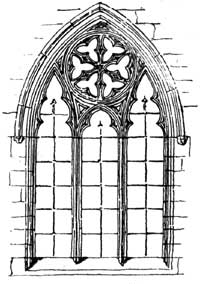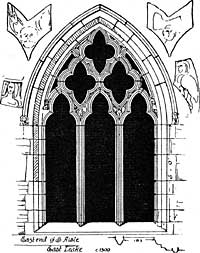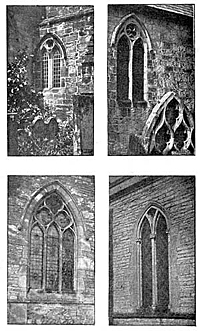
Window in south aisle, Orston.

East end of south aisle, East Leake.
The earliest form of Decorated tracery is Geometric: that is to say, it consists of arches and circles set out in accordance with the rules of geometry, so as to fill a given space (see north aisle, Burton Joyce, page 103). Further elaboration is produced by foliation, whereby plain circles are thrown into trefoils, quatrefoils, &c., by cusping. Perhaps the best example in the county is the chapter-house at Southwell, c. 1290 (see diagram); but other good illustrations may be met with in village churches, as in the south aisle at Orston (now restored on the original lines).
In some of the earliest attempts at foliation, the cusps are not enclosed within circles, but the whole light is foliated. A good example is shewn from Averham (c. 1290. Edward I.), (Plate II.), where the tracery consists of three quatrefoils, set over three grouped lancets and enclosed within an equilateral arch.

PLATE II. Chancel windows. Clockwise: Sleston, Sutton-in-Ashfield, Elston, Averham.
At East Leake, there is a window similar in design but more elaborate in detail. With the advent of the 14th century, church enlargement became general; and so, the narrow south aisle at East Leake was pulled down and entirely rebuilt, on a more generous scale. This, in turn, has been restored and partly rebuilt, on the old lines ; but there is sufficient evidence to show, that a very handsome Lady chapel—of which the piscina and the east window are all that remain—was accomplished.
The window is of three lights, and has a traceried head which baffles classification; for it combines both "plate" and "bar" tracery. It is made up of three quatrefoils conjoined; the vertical foils being pointed, while the horizontal foils are semi-circles. The spaces between the foliations are redeemed from "plate" tracery by the upper parts being carried on as moulded bars, until they reach the containing arch, and by the introduction of carving and sculpture, in the lower spandrils.
In anticipation of the coming of the glass-man with his "storied windows, richly dight," the carver has here tried his hand at a story in stone. In the left hand spandril is a female bust; in each of the two intermediate spandrils, now much" weathered and defacid," may be traced a human head, a fox, and other obscure forms; the right hand spandril is filled with the grotesque figure of a man. As none of the heads are crowned, they may have been intended to represent benefactors to the chantry, which was founded in 1308, under Raymond William de Fergis, Cardinal of Sancta Maria Nova, a well-known pluralist, who was instituted to the living by the Prior and Convent of Repton; but the real intention of the sculptor is now difficult to unfold. The window is equally beautiful when seen from within. The jambs are enriched with slender shafts having moulded caps and bases, and the soffit of the rear arch is ornamented with fine rose bosses, two on either side and one at the apex.
